英语强调句型用法分析完整
- 格式:doc
- 大小:48.00 KB
- 文档页数:8
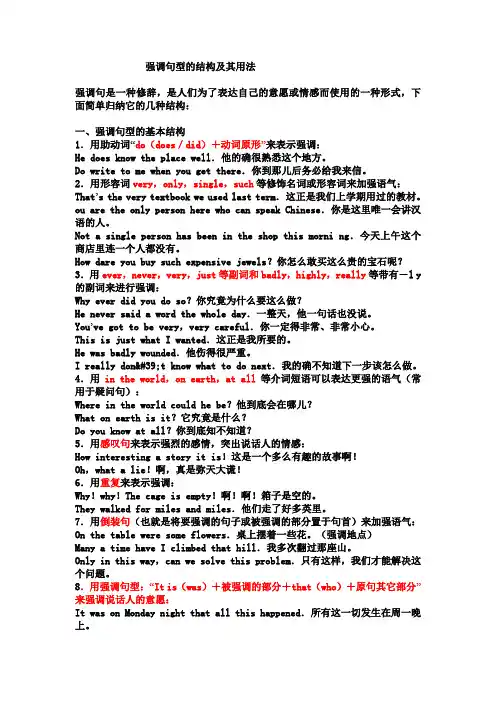
强调句型的结构及其用法强调句是一种修辞,是人们为了表达自己的意愿或情感而使用的一种形式,下面简单归纳它的几种结构:一、强调句型的基本结构1.用助动词“do(does/did)+动词原形”来表示强调:He does know the place well.他的确很熟悉这个地方。
Do write to me when you get there.你到那儿后务必给我来信。
2.用形容词very,only,single,such等修饰名词或形容词来加强语气:That’s the very textbook we used last term.这正是我们上学期用过的教材。
ou are the only person here who can speak Chinese.你是这里唯一会讲汉语的人。
Not a single person has been in the shop this morni ng.今天上午这个商店里连一个人都没有。
How dare you buy such expensive jewels?你怎么敢买这么贵的宝石呢?3.用ever,never,very,just等副词和badly,highly,really等带有-l y 的副词来进行强调:Why ever did you do so?你究竟为什么要这么做?He never said a word the whole day.一整天,他一句话也没说。
You’ve got to be very,very careful.你一定得非常、非常小心。
This is just what I wanted.这正是我所要的。
He was badly wounded.他伤得很严重。
I really don't know what to do next.我的确不知道下一步该怎么做。
4.用in the world,on earth,at all等介词短语可以表达更强的语气(常用于疑问句):Where in the world could he be?他到底会在哪儿?What on earth is it?它究竟是什么?Do you know at all?你到底知不知道?5.用感叹句来表示强烈的感情,突出说话人的情感:How interesting a story it is!这是一个多么有趣的故事啊!Oh,what a lie!啊,真是弥天大谎!6.用重复来表示强调:Why!why!The cage is empty!啊!啊!箱子是空的。
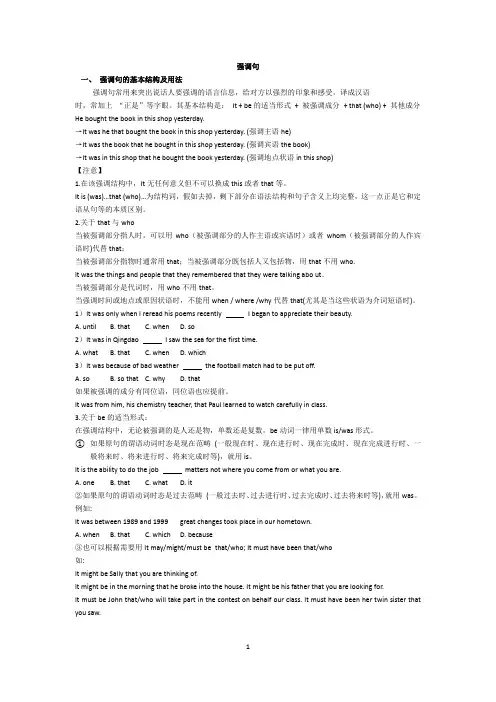
强调句一、强调句的基本结构及用法强调句常用来突出说话人要强调的语言信息,给对方以强烈的印象和感受。
译成汉语时,常加上“正是”等字眼。
其基本结构是:It + be的适当形式+ 被强调成分+ that (who) + 其他成分He bought the book in this shop yesterday.→It was he that bought the book in this shop yesterday. (强调主语he)→It was the book that he bought in this shop yesterday. (强调宾语the book)→It was in this shop that he bought the book yesterday. (强调地点状语in this shop)【注意】1.在该强调结构中,It无任何意义但不可以换成this或者that等。
It is (was)…that (who)…为结构词,假如去掉,剩下部分在语法结构和句子含义上均完整,这一点正是它和定语从句等的本质区别。
2.关于that与who当被强调部分指人时,可以用who(被强调部分的人作主语或宾语时)或者whom(被强调部分的人作宾语时)代替that;当被强调部分指物时通常用that;当被强调部分既包括人又包括物,用that不用who.It was the things and people that they remembered that they were talking abo ut.当被强调部分是代词时,用who不用that。
当强调时间或地点或原因状语时,不能用when / where /why代替that(尤其是当这些状语为介词短语时)。
1)It was only when I reread his poems recently I began to appreciate their beauty.A. untilB. thatC. whenD. so2)It was in Qingdao I saw the sea for the first time.A. whatB. thatC. whenD. which3)It was because of bad weather the football match had to be put off.A. soB. so thatC. whyD. that如果被强调的成分有同位语,同位语也应提前。
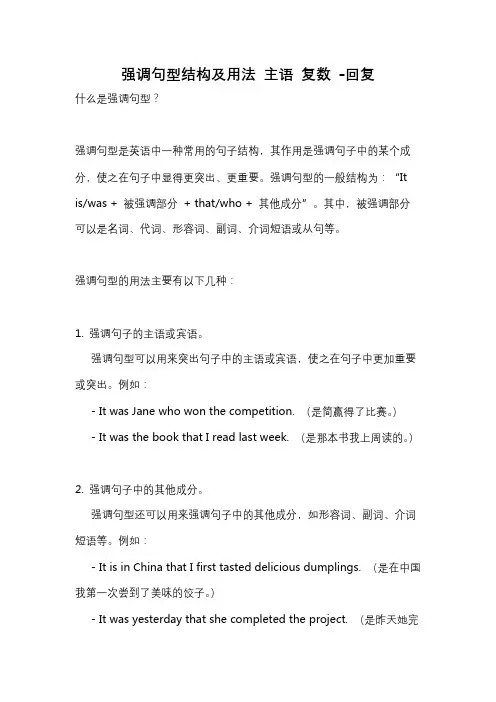
强调句型结构及用法主语复数-回复什么是强调句型?强调句型是英语中一种常用的句子结构,其作用是强调句子中的某个成分,使之在句子中显得更突出、更重要。
强调句型的一般结构为:“It is/was + 被强调部分+ that/who + 其他成分”。
其中,被强调部分可以是名词、代词、形容词、副词、介词短语或从句等。
强调句型的用法主要有以下几种:1. 强调句子的主语或宾语。
强调句型可以用来突出句子中的主语或宾语,使之在句子中更加重要或突出。
例如:- It was Jane who won the competition. (是简赢得了比赛。
)- It was the book that I read last week. (是那本书我上周读的。
)2. 强调句子中的其他成分。
强调句型还可以用来强调句子中的其他成分,如形容词、副词、介词短语等。
例如:- It is in China that I first tasted delicious dumplings. (是在中国我第一次尝到了美味的饺子。
)- It was yesterday that she completed the project. (是昨天她完成了这个项目。
)3. 强调句子中的某个时间、地点或方式。
强调句型还可以用来强调句子中的某个时间、地点或方式,使之突出。
例如:- It was at the park where they met for the first time. (就是在公园他们第一次见面的。
)- It was by train that they traveled to the city. (是乘火车他们去城市的。
)接下来,我将以“复数”为主题展开,详细探讨强调句型在强调句子中的复数形式时的用法和例句。
在强调句子中使用复数形式时,我们需要注意以下几点:1. 主语为复数时,使用复数形式。
当句子需要强调主语为复数时,我们需要使用复数形式来构造强调句型。
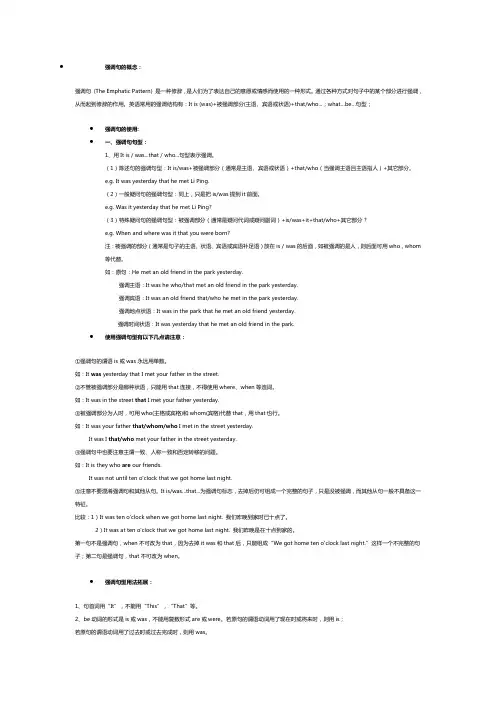
∙强调句的概念:强调句(The Emphatic Pattern) 是一种修辞,是人们为了表达自己的意愿或情感而使用的一种形式。
通过各种方式对句子中的某个部分进行强调,从而起到修辞的作用。
英语常用的强调结构有:It is (was)+被强调部分(主语、宾语或状语)+that/who...;what…be…句型;∙强调句的使用:∙一、强调句句型:1、用It is/was...that/who...句型表示强调。
(1)陈述句的强调句型:It is/was+被强调部分(通常是主语、宾语或状语)+that/who(当强调主语且主语指人)+其它部分。
e.g. It was yesterday that he met Li Ping.(2)一般疑问句的强调句型:同上,只是把is/was提到it前面。
e.g. Was it yesterday that he met Li Ping?(3)特殊疑问句的强调句型:被强调部分(通常是疑问代词或疑问副词)+is/was+it+that/who+其它部分?e.g. When and where was it that you were born?注:被强调的部分(通常是句子的主语、状语、宾语或宾语补足语)放在is/was的后面,如被强调的是人,则后面可用who,whom等代替。
如:原句:He met an old friend in the park yesterday.强调主语:It was he who/that met an old friend in the park yesterday.强调宾语:It was an old friend that/who he met in the park yesterday.强调地点状语:It was in the park that he met an old friend yesterday.强调时间状语:It was yesterday that he met an old friend in the park.∙使用强调句型有以下几点请注意:①强调句的谓语is或was永远用单数。
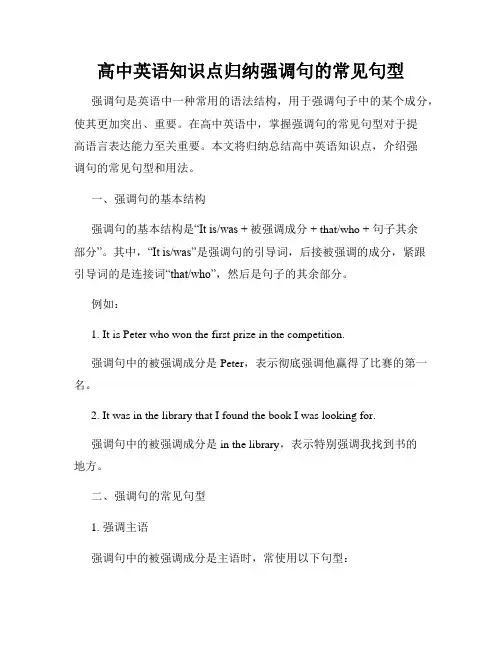
高中英语知识点归纳强调句的常见句型强调句是英语中一种常用的语法结构,用于强调句子中的某个成分,使其更加突出、重要。
在高中英语中,掌握强调句的常见句型对于提高语言表达能力至关重要。
本文将归纳总结高中英语知识点,介绍强调句的常见句型和用法。
一、强调句的基本结构强调句的基本结构是“It is/was + 被强调成分 + that/who + 句子其余部分”。
其中,“It is/was”是强调句的引导词,后接被强调的成分,紧跟引导词的是连接词“that/who”,然后是句子的其余部分。
例如:1. It is Peter who won the first prize in the competition.强调句中的被强调成分是Peter,表示彻底强调他赢得了比赛的第一名。
2. It was in the library that I found the book I was looking for.强调句中的被强调成分是in the library,表示特别强调我找到书的地方。
二、强调句的常见句型1. 强调主语强调句中的被强调成分是主语时,常使用以下句型:It is/was + 被强调的主语 + that/who + 句子其余部分例如:It was Mary who broke the window.是玛丽打破了窗户。
2. 强调宾语强调句中的被强调成分是宾语时,常使用以下句型:It is/was + 被强调的宾语 + that/who + 句子其余部分例如:It was Tom who I saw at the park.是我在公园看到的是汤姆。
3. 强调地点状语强调句中的被强调成分是地点状语时,常使用以下句型:It is/was + 被强调的地点状语 + that/where + 句子其余部分例如:It was in the kitchen that I found the missing keys.是在厨房里我找到了丢失的钥匙。
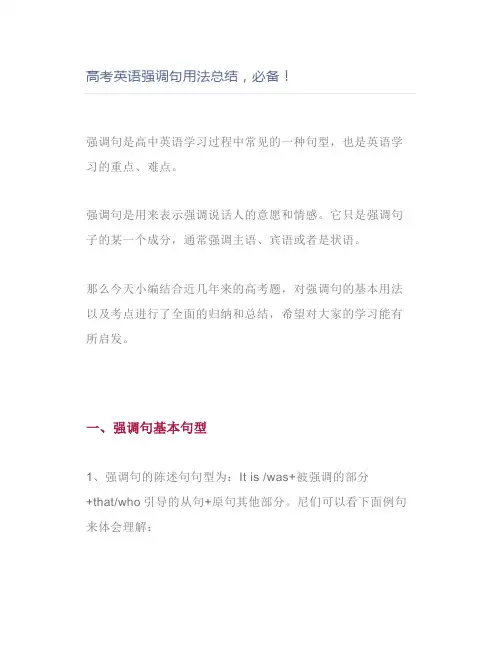
高考英语强调句用法总结,必备!强调句是高中英语学习过程中常见的一种句型,也是英语学习的重点、难点。
强调句是用来表示强调说话人的意愿和情感。
它只是强调句子的某一个成分,通常强调主语、宾语或者是状语。
那么今天小编结合近几年来的高考题,对强调句的基本用法以及考点进行了全面的归纳和总结,希望对大家的学习能有所启发。
一、强调句基本句型1、强调句的陈述句句型为:It is /was+被强调的部分+that/who引导的从句+原句其他部分。
尼们可以看下面例句来体会理解:2、强调句的一般疑问句型:Is / Was +it+被强调的部分+that/ who/ whom引导的从句+原句其他的部分。
3、强调句的特殊疑问句型:特殊疑问词(When /Where/ Why/ Who/ What/ How )+is/ was +it +that从句+原句的其他部分。
二、需要注意的问题1、无论强调据说强调的主语是单数还是复数,强调句中所用的be动词始终都是is或者是was,如果强调的是将来或者是正在发生的事情或正在进行的动作的时候,只能用is;如果强调过去已经完成的就用was。
2、大家需要记住一点,强调句去掉了it is/ was…+that之后,对于句子的完整性不造成影响,这也是与其他句子区分有一个重要标志。
三、考点归纳1、主谓一致。
在强调主语的时候,that后的谓语动词要与被强调者保持是人称和数的一致,例如:It is I who am a teacher.2、连接词。
在强调状语的时候,无论被强调的部分是表示时间还是地点, 能不能用when或者where,连接词只能用that。
同时要注意与下列句型的区分:3、考查对“not…until…”进行强调,常会使用句型“It is / was… not …until…that…”这个强调句型是高考的高频考点,意思是“不是……而是……”。
4、考查与主语从句,状语从句和定语从句的辨析强调句很容易和名词从句这个句型混淆,如:It is clear (obvious, true, possible, certain…) that…大家要清楚这里的it是形式主语,真正的主语是that引导的主语从句。
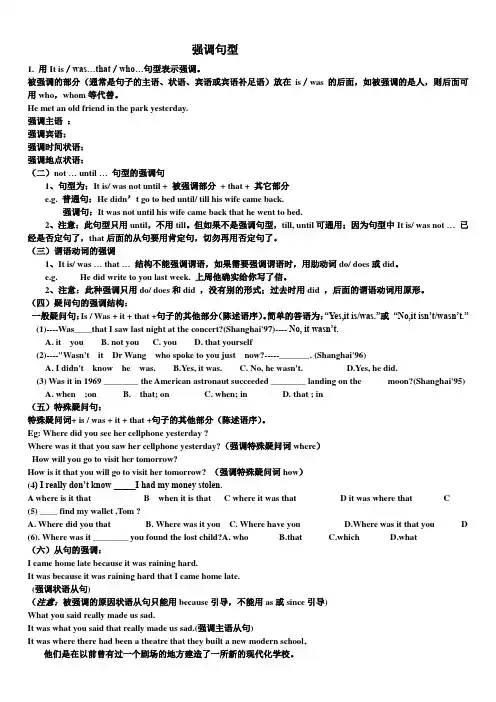
强调句型1. 用It is/was…that/who…句型表示强调。
被强调的部分(通常是句子的主语、状语、宾语或宾语补足语)放在is/was的后面,如被强调的是人,则后面可用who,whom等代替。
He met an old friend in the park yesterday.强调主语:强调宾语:强调时间状语:强调地点状语:(二)not … until …句型的强调句1、句型为:It is/ was not until + 被强调部分+ that + 其它部分e.g. 普通句:He didn’t go to bed until/ till his wife came back.强调句:It was not until his wife came back that he went to bed.2、注意:此句型只用until,不用till。
但如果不是强调句型,till, until可通用;因为句型中It is/ was not …已经是否定句了,that后面的从句要用肯定句,切勿再用否定句了。
(三)谓语动词的强调1、It is/ was … that …结构不能强调谓语,如果需要强调谓语时,用助动词do/ does或did。
e.g. He did write to you last week. 上周他确实给你写了信。
2、注意:此种强调只用do/ does和did ,没有别的形式;过去时用did ,后面的谓语动词用原形。
(四)疑问句的强调结构:一般疑问句:Is / Was + it + that +句子的其他部分(陈述语序)。
简单的答语为:“Yes,it is/was.”或“No,it isn’t/wasn’t.”(1)----Was____that I saw last night at the concert?(Shanghai'97)---- No, it wasn’t.A. it youB. not youC. youD. that yourself(2)----"Wasn't it Dr Wang who spoke to you just now?-----_______. (Shanghai'96)A. I didn't know he was.B.Yes, it was.C. No, he wasn't.D.Yes, he did.(3) Was it in 1969 ________ the American astronaut succeeded ________ landing on the moon?(Shanghai'95)A. when ;onB. that; onC. when; inD. that ; in(五)特殊疑问句:特殊疑问词+ is / was + it + that +句子的其他部分(陈述语序)。
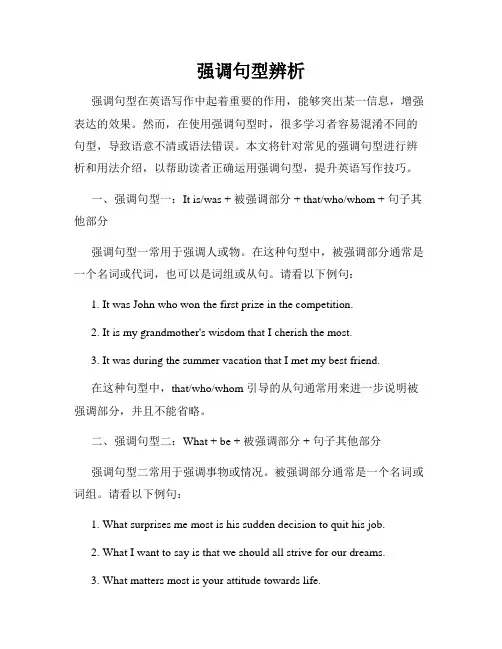
强调句型辨析强调句型在英语写作中起着重要的作用,能够突出某一信息,增强表达的效果。
然而,在使用强调句型时,很多学习者容易混淆不同的句型,导致语意不清或语法错误。
本文将针对常见的强调句型进行辨析和用法介绍,以帮助读者正确运用强调句型,提升英语写作技巧。
一、强调句型一:It is/was + 被强调部分 + that/who/whom + 句子其他部分强调句型一常用于强调人或物。
在这种句型中,被强调部分通常是一个名词或代词,也可以是词组或从句。
请看以下例句:1. It was John who won the first prize in the competition.2. It is my grandmother's wisdom that I cherish the most.3. It was during the summer vacation that I met my best friend.在这种句型中,that/who/whom 引导的从句通常用来进一步说明被强调部分,并且不能省略。
二、强调句型二:What + be + 被强调部分 + 句子其他部分强调句型二常用于强调事物或情况。
被强调部分通常是一个名词或词组。
请看以下例句:1. What surprises me most is his sudden decision to quit his job.2. What I want to say is that we should all strive for our dreams.3. What matters most is your attitude towards life.在这种句型中,被强调部分是整个句子的主语或宾语。
三、强调句型三:强调副词only、even等的使用只有、仅仅、竟然等副词的使用能够加强对某一信息的强调。
请看以下例句:1. Only when you work hard can you achieve success.2. Even my grandmother, who is 80 years old, can use a computer.3. I never expected that he would be so rude to me.在以上例句中,only、even 等副词都起到了强调作用,突出了所强调的信息。
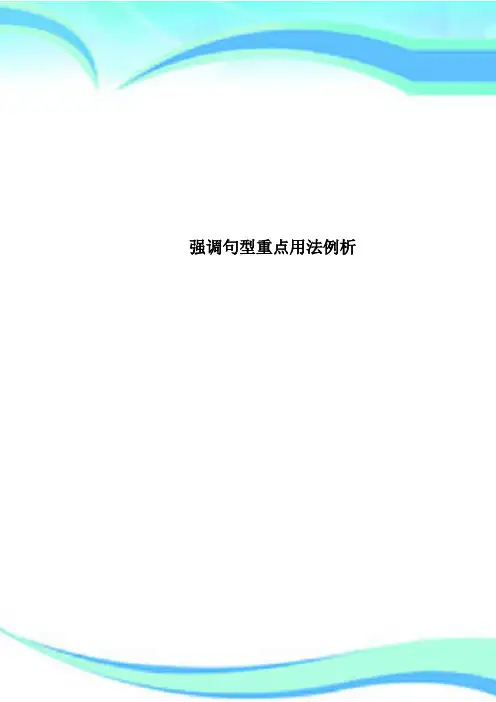

强调句型的结构及其用法强调句是一种修辞,是人们为了表达自己的意愿或情感而使用的一种形式,下面简单归纳它的几种结构:一、强调句型的基本结构1.用助动词“do(does/did)+动词原形”来表示强调:He does know the place well.他的确很熟悉这个地方。
Do write to me when you get there.你到那儿后务必给我来信。
2.用形容词very,only,single,such等修饰名词或形容词来加强语气:That’s the very textbook we used last term.这正是我们上学期用过的教材。
ou are the only person here who can speak Chinese.你是这里唯一会讲汉语的人。
Not a single person has been in the shop this morni ng.今天上午这个商店里连一个人都没有。
How dare you buy such expensive jewels?你怎么敢买这么贵的宝石呢?3.用ever,never,very,just等副词和badly,highly,really等带有-l y 的副词来进行强调:Why ever did you do so?你究竟为什么要这么做?He never said a word the whole day.一整天,他一句话也没说。
You’ve got to be very,very careful.你一定得非常、非常小心。
This is just what I wanted.这正是我所要的。
He was badly wounded.他伤得很严重。
I really don't know what to do next.我的确不知道下一步该怎么做。
4.用in the world,on earth,at all等介词短语可以表达更强的语气(常用于疑问句):Where in the world could he be?他到底会在哪儿?What on earth is it?它究竟是什么?Do you know at all?你到底知不知道?5.用感叹句来表示强烈的感情,突出说话人的情感:How interesting a story it is!这是一个多么有趣的故事啊!Oh,what a lie!啊,真是弥天大谎!6.用重复来表示强调:Why!why!The cage is empty!啊!啊!箱子是空的。
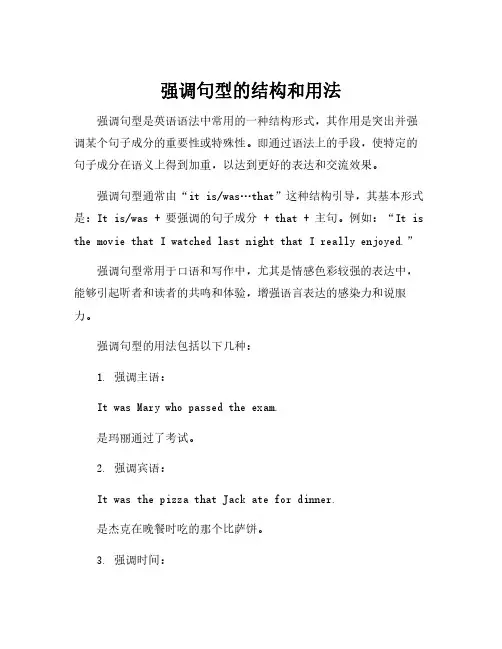
强调句型的结构和用法强调句型是英语语法中常用的一种结构形式,其作用是突出并强调某个句子成分的重要性或特殊性。
即通过语法上的手段,使特定的句子成分在语义上得到加重,以达到更好的表达和交流效果。
强调句型通常由“it is/was…that”这种结构引导,其基本形式是:It is/was+要强调的句子成分+that+主句。
例如:“It is the movie that I watched last night that I really enjoyed.”强调句型常用于口语和写作中,尤其是情感色彩较强的表达中,能够引起听者和读者的共鸣和体验,增强语言表达的感染力和说服力。
强调句型的用法包括以下几种:1.强调主语:It was Mary who passed the exam.是玛丽通过了考试。
2.强调宾语:It was the pizza that Jack ate for dinner.是杰克在晚餐时吃的那个比萨饼。
3.强调时间:It was yesterday that I met John.是昨天我遇见了约翰。
4.强调地点:It was in the park that I lost my phone.是我在公园里丢了手机。
5.强调原因:It was because of the heavy rain that the game was cancelled.是因为大雨比赛被取消了。
6.强调方式:It was in a loud voice that she answered the phone.是她用大声回答了电话。
强调句型不仅在日常交际和表达中应用广泛,而且在英语考试中也常被需要运用到。
因此,我们在学习英语的过程中,不仅需要掌握其基本形式和用法,还需要多做练习和实践,提高使用的熟练度和准确度。
强调句型归纳强调句型是英语语法中常用的一种句型结构,用于强调句子中的某个部分或者突出某个信息。
在写作中,正确运用强调句型可以使文章更加生动有力,增强表达的效果。
本文将对常见的强调句型进行归纳总结。
一、强调句型的基本结构强调句型的基本结构为"It is/was + 被强调部分 + that/who + 其他部分"。
其中,被强调部分可以是名词、形容词、副词、介词短语、动词短语等。
具体结构如下:1. It is + 被强调部分 + that + 句子的其他部分2. It was + 被强调部分 + that + 句子的其他部分二、强调句型的用法1. 强调名词强调句型可用于强调句子中的名词,使之成为句子中的重点。
例如:It is Mary who won the first prize in the competition.(重点强调Mary)It's the book on the table that I'm looking for.(重点强调book)2. 强调形容词强调句型可用于强调句子中的形容词,突出描述某个对象的特征。
例如:It is such a beautiful day that we decided to go hiking.(强调beautiful)It was the most difficult exam I have ever taken.(强调difficult)3. 强调副词强调句型可用于强调句子中的副词,加强对某个动作或状态的强调。
例如:It is always important to speak the truth.(强调always)It was only last night that I realized my mistake.(强调only)4. 强调介词短语强调句型可用于强调句子中的介词短语,使之成为句子中的重点。
例如:It is on the top of the mountain where we built our house.(强调on the top of the mountain)It was in the company of great writers that he found inspiration.(强调in the company of great writers)5. 强调动词短语强调句型可用于强调句子中的动词短语,突出某个动作或者事件的重要性。
英语强调句型用法分析山东省潍坊第七中学刘永科英语中,表示“强调”的方法有很多。
首先,在一个句子中我们可以通过嵌入某些单词或短语来实现。
例如:That is the very reason why I want to apologize to you.(very 表示“恰恰,正是”的含义,表示强调。
)What i n the world (on earth) did you mean by saying that? (in the world和on earth 两个短语都表示“究竟,到底”的含义,表示强调。
)I don’t like the picture at all.(at all 和not 连用,表示强调:“一点也不”。
)He shouldn’t be blamed for that because he is nothing but a child.(nothing but 理解为“仅仅,只不过”的意思,表示强调。
)The family did manage to send him to a technical school.(在谓语动词之前加do, does, did也可以达到强调动词词义的目的。
)但在更多的时候,我们则使用强调句型来实现“强调”之目的。
例如:It is human activity that has caused this global warming. (选修6第4单元)It引导的强调句,是英语中最常见、最常用的语言现象,也是英语学习中的重点和难点。
在我们课本里面,强调句型可以说比比皆是。
例如:I wonder if it’s because I haven’t been able to be outdoors for so long t hat I’ve grown so crazy about everything to do with nature. (必修1 第1单元) 被强调的部分是一个原因状语从句。
强调句型考点解读强调句型是高中英语中一个重要的语法项目,是高考重要考点之一。
其基本结构为:It + be+ 被强调部分+that+句子其余部分。
本文拟结合高考试题对强调句型的用法作如下归纳。
一、基本用法1.在强调句型中,能够被强调的句子成分通常为主语、宾语、状语等,不能用来强调谓语动词、表语等。
当被强调部分为sb.,且在句中作主语时,可用who,也可用that,其它情况一律用that。
强调主语时,that后的谓语动词必须与被强调的主语人称与数保持一致。
如:I am going to meet my friend at the airport tomorrow.→It is I who am going to meet my friend at the airport tomorrow.(强调主语)It is my friend that I’m going to meet at the airport tomorrow.(强调宾语)It is at the airport that I’m going to meet my friend tomorrow.(强调地点状语)It is tomorrow that I’m going to meet my friend at the airport.(强调时间状语)2.在强调结构中,无论被强调的是人还是物,单数还是复数,be动词一律用单数is/was形式。
如果原句的谓语动词时态是过去范畴,就用was; 如果原句的谓语动词时态是现在或将来范畴,就用is。
例如:It is Tom and Mary who will be fined.It was yesterday that he arrived here.二、考点解读1.强调句型的一般疑问句结构为:“Is /Was it+ 被强调部分+that+句子其余部分?”例1.Was it during the Second World War ____ he died? (MET88)A. thatB. whileC. in whichD. then例2.Was _____that I saw last night at the concert?(上海97)A. it youB. not youC. youD. that yourself例3.--- Wasn’t it Dr. Wang who spoke to you just now?--- ______. (上海96)A. I didn’t know he wasB. Yes, it wasC. No, he wasn’tD. Yes, he did解析:此句为强调句的一般疑问句的否定形式。
强调句型讲解和练习一、定义强调句,是基本语法,是一种修辞,是人们为了表达自己的意愿或情感而使用的一种形式。
英语常用的强调结构是"It is (was)+被强调部分(主语、宾语或状语)+who (that)..."。
通过各种方式对句子中的某个部分进行强调,从而起到修辞的作用。
一般说来,被强调部分指人时,用who;指事物时用that,但that也可以指人。
二,强调的形式(1)用do\does\did + V可表强调Some people do believe that nuclear power poses a threat to the world peace.(2)adv或adj可表强调:Never \ only\ VeryThis is the very question that deserves careful analysis.(3)双重否定可表强调Taking part-time jobs is never without drawbacks.(4)what引导的主从可表强调What really matters is cooperation.(5)倒装可表强调(凡是倒装都可以表示强调)Little do people take into account the seriousness of this problem.(6)比较状语从句可表强调Nothing is more imperative than to learn from the past.(7)强调句型可表强调It is \was +被强调部份+ that \ who +原句剩余部份It is s tability that destroys people’s ambition and barricades people’s steps.三,强调语气的句型(1). 陈述句的强调句型It is/ was + 被强调部分(通常是主语、宾语或状语)+ that/ who(当强调主语且主语指人)+ 其他部分。
1. 强调结构的陈述式强调结构的陈述式为“It is (was)+ 被强调部分+ that (who)…”。
该结构可用于强调主语、宾语、状语等,但不能强调谓语动词。
该句式中用that或who的区别是:当被强调的指人时,用that或who均可;当被强调的不是指人时,则只能用that(注意不用which)。
如:It was in the office that he was killed. 他是办公室被杀害的。
(强调in the office)It is the children who broke the window. 是孩子们打破窗户的。
(强调the children)It was to you and not anyone else that I lent the money. 我只借钱给你,不借给其他人。
(强调to you and not anyone)It is only when you have your own children that you realize the troubles of parenthood. 当你有了自己的孩子,才能真切地了解到双亲的辛苦。
(强调only when you have your own children)2. 一般疑问句的强调结构一般疑问句的强调结构就是将be提到句首,即使用“Is / Was it+ 被强调部分+ that / who…”。
如:Is it Tommy who answered the telephone? 是汤米接的电话吗? Is it from advertising that a newspaper earns a lot of its profits? 报纸获利最多的部分是在于广告收入吗?3. 特殊疑问句的强调结构特殊疑问句的强调结构句型为“疑问词(Who / What / When / Where / Why / How)+is / was it that…”这样的形式。
英语篇强调句是英语中常见的句型之一,也是中考的一个热门考点。
它是通过对句子中的某个部分进行强调,以突出说话人的意愿和情感。
对此,笔者剖析了英语强调句的基本用法,并提出了几点注意事项,以期同学们能够准确把握和运用。
一、强调句的基本用法1.陈述句句型:It is/was+被强调部分+that/who+其他。
强调人时,既可用who,又可用that,其他强调则一律用that。
例如:My mother bought a lot of bread in the su-permarket yesterday.昨天我妈妈在超市买了许多面包。
→It was my mother that/who bought a lotof bread in the supermarket yesterday.昨天在超市买了许多面包的是我妈妈。
(强调主语)→It was a lot of bread that my motherbought in the supermarket yesterday.昨天我妈妈在超市买了许多面包。
(强调宾语)→It was yesterday that my mother boughta lot of bread in the supermarket.我妈妈是昨天在超市买了许多面包。
(强调时间状语)→It was in the supermarket that my moth-er bought a lot of bread yesterday.昨天我妈妈是在超市买了许多面包。
(强调地点状语)2.一般疑问句句型:Is/was+被强调部分+that/who+其他。
例如:Jack visited his grandparents in the coun-try last Sunday.上周日杰克去乡下看望了他的爷爷奶奶。
→Was it Jack that/who visited his grand-parents in the country last Sunday?上周日是杰克去乡下看望了他的爷爷奶奶吗?(强调主语)→Was it his grandparents that/who Jackvisited in the country last Sunday?上周日杰克去乡下看望的是他爷爷奶奶吗?(强调宾语)→Was it in the country that Jack visitedhis grandparents last Sunday?上周日杰克是去乡下看望他爷爷奶奶吗?(强调地点状语)英语强调句的用法剖析甘肃省定西市安定区宁远初级中学解莹中考零距离36。
英语强调句型用法分析山东省潍坊第七中学刘永科英语中,表示“强调”的方法有很多。
首先,在一个句子中我们可以通过嵌入某些单词或短语来实现。
例如:That is the very reason why I want to apologize to you.(very 表示“恰恰,正是”的含义,表示强调。
)What i n the world (on earth) did you mean by saying that? (in the world和on earth 两个短语都表示“究竟,到底”的含义,表示强调。
)I don’t like the picture at all.(at all 和not 连用,表示强调:“一点也不”。
)He shouldn’t be blamed for that because he is nothing but a child.(nothing but 理解为“仅仅,只不过”的意思,表示强调。
)The family did manage to send him to a technical school.(在谓语动词之前加do, does, did也可以达到强调动词词义的目的。
)但在更多的时候,我们则使用强调句型来实现“强调”之目的。
例如:It is human activity that has caused this global warming. (选修6第4单元)It引导的强调句,是英语中最常见、最常用的语言现象,也是英语学习中的重点和难点。
在我们课本里面,强调句型可以说比比皆是。
例如:I wonder if it’s because I haven’t been able to be outdoors for so long t hat I’ve grown so crazy about everything to do with nature. (必修1 第1单元) 被强调的部分是一个原因状语从句。
不仅如此,在近几年的高考试题中,强调句亦频繁出现。
例如:It wasn’t until nearly a month later ______ I received the manager’s reply. (2005 全国)A. sinceB. whenC. asD. that(此题考查“not…until…”的强调句型,答案是D。
由于被强调的部分是时间状语,命题者给了三个与时间有关的干扰选项。
但不要忘记这是一个强调句型,选that没错。
)--- ______ that he managed to get the information? (2005山东)--- Oh, a friend of his helped him.A. Where was itB. What was itC. How was itD. Why was it(此题考查的内容虽然是“方式”,而不是强调句本身,但这4个选项全都用了强调句型的特殊疑问式,无疑增加了理解的难度。
句子的意思是:他究竟是怎样设法得到这消息的?答案是C。
)下面总结归纳it强调句型的用法及其注意要点。
强调句型的构成是:It is (was) + 被强调部分+ that (who) + 句子的其他成分。
被强调的部分放在It is (was) 之后,其它部分置于that 之后。
被强调部分可以是主语,宾语,表语或状语。
强调的主语如果是人,可以由who代替that。
如果把该句型结构还原,应该是一个完整无缺的句子。
这也是判断强调句型与其它从句的一种方法。
1. 被强调的成分举例原句:Tom found my pen in the classroom yesterday.强调主语:It was Tom that found my pen in the classroom yesterday.强调宾语:It was my pen that Tom found in the classroom yesterday.强调地点状语:It was in the classroom that Tom found my pen yesterday.强调时间状语:It was yesterday that Tom found my pen in the classroom.2. 强调句型的一般疑问式直接把is或was提到it之前即可。
例如:Was it Tom that found your pen in the classroom yesterday?Was it in 1939 that the Second World War broke out?3. 强调句型的特殊疑问式特殊疑问词+ is (was) it + that +句子的其他成分。
特殊疑问词即是被强调的成分,例如:Who was it that found your pen in the classroom yesterday?When was it that the Second World War broke out?4. 用It is 还是It was?我们可以根据原句时态来确定用It is 还是It was。
如果原句时态属于现在时间范畴(包括一般现在时,现在进行式,现在完成时,一般将来时等),则用It is …;如果原句时态属于过去时间范畴(包括一般过去时,过去进行时,过去完成时,过去将来时等),则用It was … 例如:What is it that you want me to do now?Was it John that broke the window this morning?5. that (who) 有时可以省略随着语言的发展,这种强调句型中的that或who有时可以省略。
例如:It was my brother (that/whom) you saw the other day.It was William (who) did it.我们知道有这种省略现象而已,但尽量不要模仿,以免出错。
6. 并非所有的成分都可以强调课本上讲,“可以对句子中除谓语动词以外的成分加以强调”,这种说法是不准确的。
除了谓语动词不可强调以外,并不是所有的表语和状语都可以强调。
如,形容词作表语就不可以强调,表示程度和方式的单个副词也不能强调。
例如:* It is beautiful that Mary is.(应改为:Mary is really beautiful.)* It was hard that Tom worked.(应改为:Tom worked hard indeed.)7. 强调原因状语从句要注意若从句由as或since引导,强调时则改为because,这是因为,because引导的原因从句表示的意义非常强烈,符合强调句的目的。
例如:As she got up late, she missed the first bus. 变为:It was because she got up late that she missed the bus.8. 强调句的否定转移有些否定句在变成强调句时,要把否定转移到被强调的词语之前。
尤其是“not… until…”句式的强调要特别注意。
例如:Money can’t buy everything. 变为:It is not everything that money can buy.He didn’t realize his mistake until the teacher had told him. 变为:It wasn’t until the teacher had told him that he realized his mistake.最后一句应注意,在强调句式中,虽然not被提前,但“not… until…”句型不要到装。
不可说:*It wasn’t until the teacher had told him did he realize his mistake.(全文完一、用"DO"Do常用于一般现在时或一般过去时,放在行为动词前,加强语气,表示说话者坚定的语气;Do用在祈使句中时,可使请求或邀请显得更有诚意。
例如:1.You do look nice today.你今天看上去真好。
2.I did go to the station to meet her but I didn't see her.我确实去车站接她了,但我没见到他。
3.He doesn't often visit me but when he does visit me,he staysfor hours.他不常来看我,但一旦他来时,总要呆好几小时。
4.Do help me,please.请务必帮帮我。
5.Do be careful.请多加小心。
二、用"It is /was…that/who…"结构来加强语气该句型可以把一个普通的陈述句转变成强调句。
转换时,我们只需把陈述句中被强调的部分放在It is/was和that/who之间,其余部分照抄。
下面第一句是陈述句,其他各例分别强调了陈述句中的主语、宾语、状语。
I met an old classmate of mine in the street the other day.几天前我在街上碰到了一位老同学。
1.It was I who/that met an old classmeate of mine in thestreet the other day.是我(不是别人)几天前在街上碰到老同学的。
2.It was an old classmate of mine whom/thatI met in thestreet the other day.几天前我在街上碰到的是我的老同学(不是别的什么人)。
3.It was in the street that I met an old classmate of mine theother day.几天前我是在街上(不是在商店或别的地方)碰到一位老同学的。
4.It was the other day that I met an old classmate of mine inthe street.我是几天前(不是别的时候)在街上碰到我的老同学的。
注:1.该句型通常只能用来强调(1)主语、(2)宾语、(3)状语(从句),不能强调谓语和定语;2.当被强调的是人时,我们常用who。
但不管被强调的是人还是物,是时间还是地点,我们都可以用that;3.是用it is 还是用it was,取决于被强调的陈述句的时态。